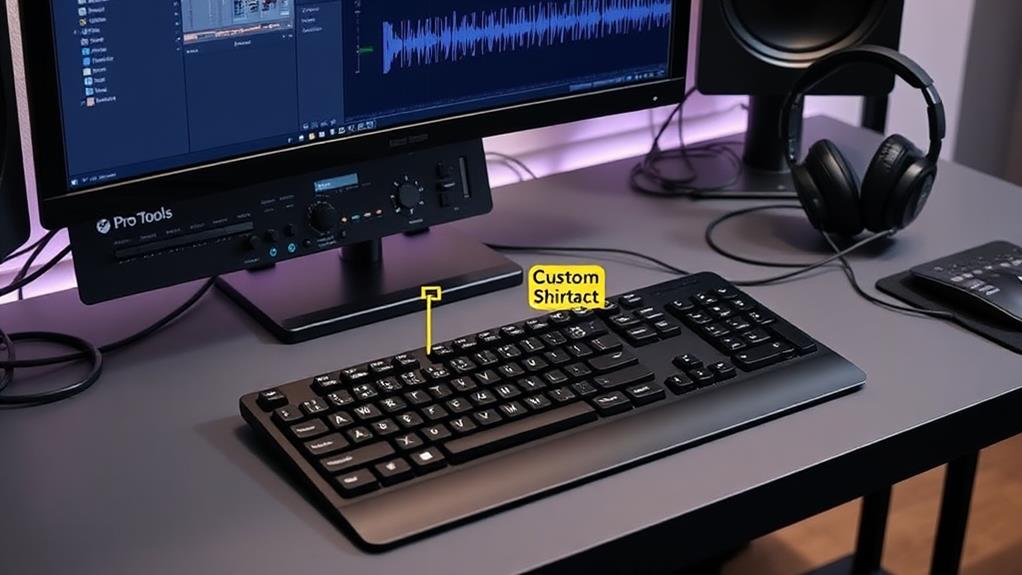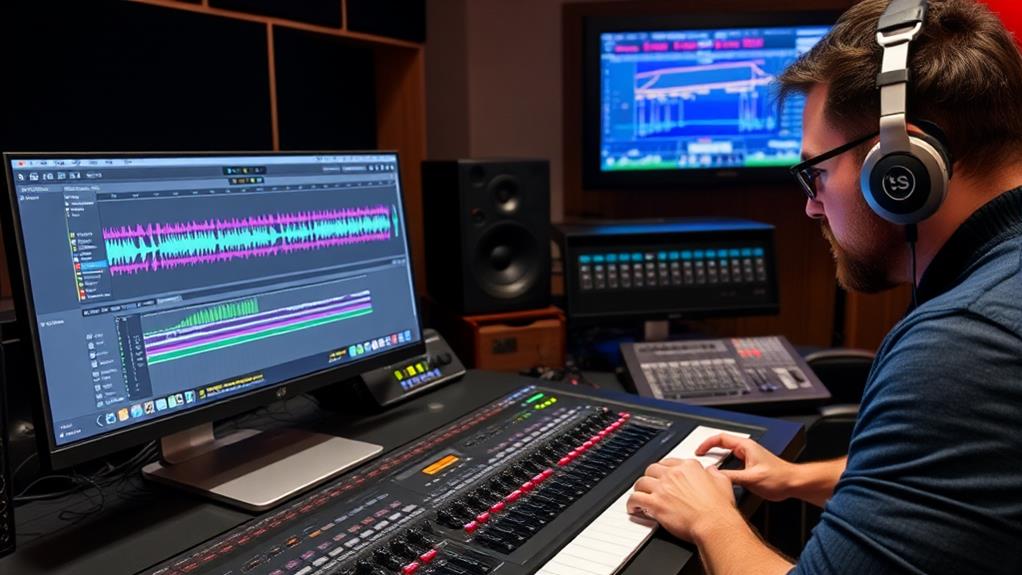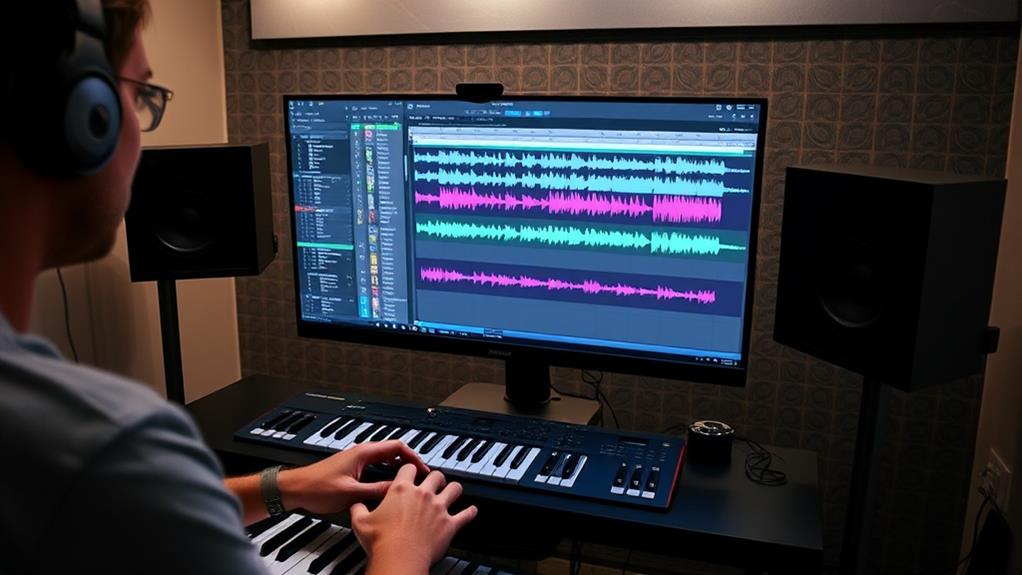Creating a master chain in Pro Tools requires a precise approach using essential plugins and techniques. Begin with EQ, like FabFilter Pro Q3, to manage tonal balance and dynamic EQ adjustments. Follow with compression using the SSL Compressor for mix cohesion and FabFilter Pro MB for multiband control. Conclude with limiting via FabFilter Pro L2, ensuring loudness and clarity without distortion. For added saturation, consider ATR 102 EQ alongside Pultec for vintage tones. Each plugin serves a critical function in preserving dynamics and artistic intent. Discovering how these tools interact will further refine your mastering process for professional results.
Key Takeaways
- Use FabFilter Pro Q3 for precise dynamic EQ adjustments to manage frequency balance effectively.
- Employ SSL Compressor to add cohesive “glue” and unify mix elements for a polished sound.
- Integrate FabFilter Pro MB for managing low end and midrange with multiband compression.
- Apply FabFilter Pro L2 for transparent limiting to achieve target loudness without distortion.
- Enhance tonal balance with ATR 102 EQ, utilizing tape saturation for added warmth and character.
Mastering Fundamentals
Mastering Fundamentals is an intricate process that focuses on three essential aspects: EQ, compression, and limiting. These elements collectively enhance the final mix’s quality while preserving its dynamics. The objective is to achieve a polished version of the original mix with minimal processing, guaranteeing the artist’s vision remains intact.
EQ adjustments, using tools like the FabFilter Pro Q3, allow for precise dynamic adjustments, critical for audio restoration and removing unwanted frequencies. Compression then follows, balancing the dynamic range and guaranteeing consistency across the track.
Limiting, particularly with tools such as the FabFilter Pro L2, is the final step to reach target loudness while maintaining clarity. Reference tracks are indispensable during this phase, providing a benchmark for achieving the desired sound quality.
Hybrid mastering, combining both hardware and software techniques, offers flexibility and peak sound quality tailored to each project. Continuous learning and experimentation with different plugins and settings are essential for developing effective mastering skills.
This approach guarantees each project benefits from meticulously crafted audio restoration and achieves the highest possible fidelity, aligning with industry standards and artistic intent.
EQ and Compression Tools
When diving into the domain of EQ and compression tools for mastering, the choice of plugins can greatly influence the final sound quality of the project.
For rock music, the ATR 102 EQ plugin stands out due to its tape saturation capabilities, which enhance the overall sound quality. This plugin is particularly effective in maintaining tonal balance while adding a subtle warmth that is characteristic of analog tape.
The FabFilter Pro Q3 is another vital tool, renowned for its user-friendly graphical interface and dynamic EQ capabilities. This plugin excels in making precise adjustments, allowing for meticulous control over the frequency spectrum, which is essential for achieving an ideal dynamic range.
For multiband compression, the FabFilter Pro MB is indispensable. It is adept at managing low end and midrange frequencies, ensuring that the mix remains balanced and each element retains its clarity.
The SSL Compressor is often employed to add a cohesive “glue” to the mix, unifying disparate elements into a seamless whole.
Lastly, the Pultec EQ provides a vintage feel, enabling subtle tonal enhancements through its unique boosting capabilities. This helps in achieving a well-rounded tonal balance without compromising the mix’s original character.
Limiting Techniques
Achieving ideal loudness while preserving the track’s dynamics requires a nuanced approach to limiting techniques. The use of limiters during mastering is essential, as they help achieve the desired loudness without sacrificing the intricacies of the audio. A favored tool in the industry, the FabFilter Pro L2, is renowned for its clean sound and precise transient control.
Understanding and optimizing limiter settings is vital to avoid unwanted distortion and maintain the track’s integrity.
- FabFilter Pro L2: Known for its transparency and versatility, it supports various limiter settings tailored to different musical genres and styles.
- Ozone 10 Algorithms: Modern innovations enhance transient control, offering improved loudness and clarity without compromising the original vibe.
- Soft Clipping: Placing a soft clipper at the start of the processing chain can greatly shape the sound, allowing for aggressive limiting without harsh digital artifacts.
- EQ and Limiting Relationship: Proper EQ adjustments before limiting guarantee that the limiter operates more efficiently, reducing the risk of distortion and preserving tonal balance.
Employing these techniques requires a deep understanding of both the tools at hand and the sonic goals of the project, guaranteeing the final master is both loud and dynamically rich.
Software Tools
In the domain of digital audio workstations, Pro Tools users can notably enhance their mastering capabilities by leveraging a suite of sophisticated software tools. Effective plugin integration is vital for achieving professional sound design.
Essential plugins such as FabFilter Pro Q3 offer dynamic EQ adjustments, allowing for precise tonal balancing across the frequency spectrum. This strategic use of EQ can considerably improve the overall sound quality of a track.
For limiting, the FabFilter Pro L2 is indispensable, providing precise control over the final output level, ensuring that the track remains punchy yet free of distortion.
The Ozone 10 suite is another formidable tool, renowned for its thorough mastering capabilities. Its advanced features, such as intelligent maximizers and dynamic EQ, help maintain sound integrity during intensive processing.
Multiband compression is essential for mastering, and tools like FabFilter Pro MB allow for discrete control over specific frequency ranges, ensuring a polished final output without the risk of over-processing.
Additionally, experimenting with plugins like Newfangled Audio Elevate can offer unique sound exploration opportunities through clipping and transient manipulation, leading to tailored and innovative mastering results.
These software tools collectively contribute to achieving a superior and refined master chain in Pro Tools.
Mastering Philosophy
Mastering philosophy hinges on the principle of achieving high-quality results with minimal processing to maintain the integrity of the original mix. This philosophy underscores the importance of a mastering mindset that emphasizes subtlety over drastic changes.
Top mastering engineers often rely on single EQ settings, creating impactful results without excessive alterations, thereby ensuring that the original artistic integrity is preserved.
Key elements of mastering philosophy include:
- Minimal Processing: Aim to enhance the mix subtly, using tools to polish rather than transform.
- Single EQ Settings: Employ precise EQ adjustments to achieve a balanced sound without over-processing.
- Artistic Integrity: Maintain the essence of the original mix, reflecting the artist’s vision in the final output.
- Continuous Learning: Stay updated with new techniques and tools, such as Ozone 10, to refine the mastering process.
In mastering, the goal is to present a polished version of the artist’s work, enhancing the mix while ensuring the final product does not overshadow its core essence.
Frequently Asked Questions
What Plugins Needed for Mastering?
Necessary plugins for mastering include FabFilter Pro Q3 for precise EQ adjustments, FabFilter Pro MB and SSL Compressor for advanced compression techniques, FabFilter Pro L2 for effective limiting strategies, and specialized metering tools to guarantee accurate level monitoring.
How Do You Make a Mastering Chain?
To create a mastering chain, begin with EQ to balance frequencies, followed by multiband compression for dynamic control. Next, use a soft clipper, then a limiter to achieve desired loudness levels. Regularly evaluate and adjust mastering techniques.
How Do I Create a Master Channel in Pro Tools?
To create a master channel in Pro Tools, navigate to the “Track” menu, select “New,” and choose an “Audio Track.” Name it “Master” for clarity. Route all individual tracks to this channel, enhancing audio quality using advanced mastering techniques.
Can Pro Tools Be Used for Mastering?
Yes, Pro Tools is highly suitable for mastering, offering advanced mastering techniques and tools that guarantee exceptional audio quality. The software’s compatibility with third-party plugins and precise editing capabilities make it an industry-standard choice for mastering engineers.
Conclusion
In mastering audio within Pro Tools, the application of EQ and compression tools, along with effective limiting techniques, is paramount. Utilizing specific software tools enhances these processes, ensuring a polished final product. Adhering to a solid mastering philosophy, which emphasizes balance and clarity, is essential for achieving professional-grade results. Mastering, consequently, is a meticulous craft that integrates technical precision with an analytical approach to optimize audio quality and consistency across various playback systems.




